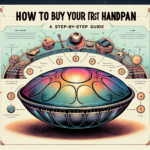The world of music is incredibly diverse and full of unique instruments that bring distinct sounds to our auditory experiences. The Aura handpan is one such instrument that has gained a lot of attention for its ethereal sounds and aesthetic design. Whether you are a seasoned musician or a complete beginner, the Aura handpan offers a new world of melodious possibility. This guide aims to provide you with an introductory pathway into playing the Aura handpan, shedding light on its history, structure, and basic playing techniques.
What is an Aura Handpan?
The Aura handpan is a type of handpan, a musical instrument that belongs to the idiophone class. Idiophones are instruments that produce sound primarily by way of the instrument’s vibrating body, without the use of strings, membranes, or external resonators. The handpan consists of two hemispherical shells of steel, bound together to form a convex lens shape. The top shell, called the “ding” side, typically features a central note surrounded by a circle of additional notes, while the bottom “gu” side is often equipped with a central hole for sound resonance.
The Aura handpan is known for its melodious, harmonious, and calming tones that can range from delicate and soft to deep and resonant, making it a favorite among new age and world music enthusiasts.
History of the Handpan
The handpan is a relatively new instrument, with its origins tracing back to the year 2000 in Bern, Switzerland. Invented by instrument builders Felix Rohner and Sabina Schärer of PANArt Hangbau AG, the original instrument was named the “Hang.” The word “Hang” means “hand” in the Bernese German dialect, emphasizing the hand-playing technique of the instrument. The term “handpan” emerged later as a generic name to describe the various types of instruments that have evolved from the original Hang design.
Aura handpans are a modern iteration of the handpan design, often crafted with specific sonic and aesthetic enhancements to meet the varied musical needs of today’s players.
Getting Started with the Aura Handpan
Choosing Your Handpan
The first step in learning how to play the Aura handpan is selecting the right instrument. Aura handpans come in various scales, each with a unique set of notes and tonal characteristics. It’s important to explore different scales and find one that resonates with your musical preferences and emotional connection. Some popular scales include the D minor, Celtic minor, and the Kurd scale. Each scale offers distinct musical possibilities and emotional expressions.
Understanding the Layout
The layout of the Aura handpan is designed to be intuitive, but understanding it is essential to mastering the instrument. The central note on the handpan is called the “ding,” surrounded by a circle of additional notes. The number of notes can vary, but typically ranges from 7 to 9. Each note is carefully tuned to ensure harmony when played in combination or sequence. Familiarize yourself with the location of each note to develop muscle memory, which is crucial for fluid playing.
Basic Playing Techniques
While the Aura handpan may look complex, playing it involves straightforward techniques that anyone can learn with practice. Here are some basic techniques to get you started:
Hand Positioning and Striking
Position your hands comfortably over the ding side of the handpan, using your fingertips or the soft pads of your fingers to strike the notes gently. Avoid using your nails or hard parts of your fingers to prevent damaging the instrument. Play around with different striking techniques to discover the varied tonal possibilities of each note.
Playing Rhythms
Start by practicing simple rhythmic patterns to build your coordination and timing. Even and steady strikes will help you produce clean notes. As you progress, experiment with more complex rhythms to add texture and dynamics to your playing.
Melodies and Chords
Once you’re comfortable with basic rhythms, try combining notes to create melodies and chords. The layout of the notes on the Aura handpan is designed to facilitate harmonic playing, so don’t hesitate to explore different note combinations. Keep your movements fluid and remember to play with intention and emotion.
Expanding Your Skills
Learning from Resources
There are numerous resources available to help you expand your Aura handpan skills. Online tutorials, instructional videos, and sheet music specifically for handpans can provide structured learning pathways. Joining handpan communities, both online and offline, offers opportunities to connect with other players, share experiences, and learn new techniques.
Improvisation and Composition
One of the most rewarding aspects of playing the Aura handpan is the freedom to improvise and create your own music. As you gain confidence and familiarity with the instrument, start experimenting with improvisation. Let your intuition guide you and focus on expressing your emotions through your playing. Composing original pieces can also be a fulfilling way to harness your creativity and musicality.
Performance and Recording
Once you feel confident in your playing, consider sharing your music through live performances or recording sessions. Performing for an audience can be a thrilling experience, allowing you to connect with listeners on an emotional level. Recording your music provides an opportunity to document your progress and share your unique sound with a wider audience.
Conclusion
The Aura handpan is a captivating instrument that offers endless possibilities for musical expression. By understanding its history, structure, and basic playing techniques, you can embark on a rewarding journey of learning and creativity. Whether you’re playing for personal enjoyment, relaxation, or artistic expression, the Aura handpan is sure to bring a profound sense of fulfillment and joy to your musical endeavors. Embrace the learning process, remain open to exploration, and let the melodic tones of the Aura handpan become a beautiful part of your musical journey.
FAQs
1. How do I maintain and care for my Aura handpan?
Maintaining your Aura handpan involves regular cleaning and protection against environmental factors. Wipe the surface with a microfiber cloth after playing to remove oils and sweat. Store it in a hard case when not in use to protect it from dents, scratches, and temperature/humidity fluctuations.
2. How can I tune my Aura handpan if it goes out of tune?
Tuning a handpan is a complex process that requires professional expertise. It is recommended to contact the manufacturer or a skilled handpan tuner for re-tuning to ensure the instrument retains its original sound quality.
3. Can I play the Aura handpan with mallets?
While the Aura handpan is primarily designed to be played with hands, using soft-mallets is possible. However, striking too hard with mallets can damage the surface and alter the tuning, so it’s advisable to use gentle, controlled strokes.
4. What is the difference between an Aura handpan and the original Hang?
The Aura handpan and the original Hang share similar designs and concepts but differ in construction techniques, materials, and sound properties. The Aura handpan offers modern enhancements and a variety of scales, providing a broader range of sonic possibilities compared to the original Hang.
5. How long does it take to learn to play the Aura handpan?
The time required to learn the Aura handpan varies based on individual dedication and prior musical experience. Basic playing techniques can be learned in a few weeks, but mastering the instrument, including complex rhythms and improvisation, can take months or even years of consistent practice.





